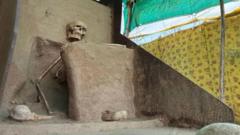The historical significance of Vincent Van Gogh's last work, "Tree Roots," has sparked a heated conflict in Auvers-sur-Oise, as the municipality asserts claims over privately-owned land related to the roots depicted in the painting.**
Controversy Over Van Gogh’s Legacy: The Battle for Tree Roots in Auvers-sur-Oise**

Controversy Over Van Gogh’s Legacy: The Battle for Tree Roots in Auvers-sur-Oise**
A recent ruling has escalated the tensions around the preservation of a tree root featured in Vincent Van Gogh's final painting, igniting a local dispute between residents and landowners.**
In the picturesque village of Auvers-sur-Oise, a site recognized as a sanctuary for artists, a recent determination regarding Vincent Van Gogh's last painting, “Tree Roots,” has incited a fierce debate among locals. This village, situated close to Paris, has long been a pilgrimage destination for enthusiasts eager to trace the final days of the iconic painter.
The contention began when art historians confirmed that Van Gogh's “Tree Roots”—characterized by its representation of gnarled roots depicted on a hillside—was created on the day of his tragic demise. This revelation settled the long-standing speculation surrounding the timeline of his works but triggered a new dispute between the town's officials and the owners of the land where the roots exist.
The specific root, famously described as the "elephant" by fans and identified with a black locust tree, sits adjacent to a public road. Following its identification as a significant historical element, the municipality of Auvers claimed a portion of the adjacent privately-owned land, arguing that its public value necessitated maintenance from the local government. The landowners, Jean-François and Hélène Serlinger, contested this claim, and a recent court adjudication found insufficient grounds for the municipality’s assertion.
Despite this ruling, Mayor Isabelle Mézières has signaled her intent to pursue further legal recourse, asserting that the iconic roots should remain accessible to all Auvers residents, in a passionate plea shared via social media. "The Roots belong to the Auversois!" she proclaimed.
The ongoing struggle over the roots has introduced a shadow over the typically vibrant atmosphere of Auvers-sur-Oise, a community of approximately 7,000 whose economy thrives on art tourism, especially during spring—a season usually bustling with visitors celebrating Van Gogh's work. The village now anticipates continued tensions as the fight over the legacy of one of history's most significant artists unfolds.
The contention began when art historians confirmed that Van Gogh's “Tree Roots”—characterized by its representation of gnarled roots depicted on a hillside—was created on the day of his tragic demise. This revelation settled the long-standing speculation surrounding the timeline of his works but triggered a new dispute between the town's officials and the owners of the land where the roots exist.
The specific root, famously described as the "elephant" by fans and identified with a black locust tree, sits adjacent to a public road. Following its identification as a significant historical element, the municipality of Auvers claimed a portion of the adjacent privately-owned land, arguing that its public value necessitated maintenance from the local government. The landowners, Jean-François and Hélène Serlinger, contested this claim, and a recent court adjudication found insufficient grounds for the municipality’s assertion.
Despite this ruling, Mayor Isabelle Mézières has signaled her intent to pursue further legal recourse, asserting that the iconic roots should remain accessible to all Auvers residents, in a passionate plea shared via social media. "The Roots belong to the Auversois!" she proclaimed.
The ongoing struggle over the roots has introduced a shadow over the typically vibrant atmosphere of Auvers-sur-Oise, a community of approximately 7,000 whose economy thrives on art tourism, especially during spring—a season usually bustling with visitors celebrating Van Gogh's work. The village now anticipates continued tensions as the fight over the legacy of one of history's most significant artists unfolds.











